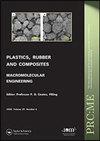The effects of resin rate (wt-%) on different temperature performance of newly designed friction composites for automobile brake lining applications
IF 1.2
4区 材料科学
Q3 MATERIALS SCIENCE, COMPOSITES
引用次数: 1
Abstract
ABSTRACT Choosing the amount of binder resin in a brake lining composition is important in terms of avoiding structural deterioration of the brake lining composite and resisting mechanical and thermal stresses at different temperatures. This study evaluated the performances of new brake lining composites with 15% and 20% novolac resin additives by performing wear tests in different temperature environments. Friction wear tests were performed according to ASTM G99 using pin-on-disc test devices at temperatures of 23°C, 150°C and 300°C. The hardness and density of the samples increased by 2.4% and 3.7%, respectively, with the increase of the novolac resin ratio in the composition. In general, it was observed that the friction coefficient, thermal conductivity and vibration increased in parallel with the resin ratio. In addition, increasing the test temperature led to an increase in the friction coefficient.研究了树脂率(wt-%)对新型汽车制动衬片摩擦复合材料不同温度性能的影响
摘要选择结合树脂在制动片组合物中的用量对于避免制动片组合物的结构劣化和抵抗不同温度下的机械和热应力具有重要意义。通过不同温度环境下的磨损试验,对添加15%和20%新伏拉克树脂的新型制动衬片复合材料的性能进行了评价。摩擦磨损试验根据ASTM G99,在23°C、150°C和300°C的温度下使用销盘试验装置进行。随着新酚醛树脂配比的增加,样品的硬度和密度分别提高了2.4%和3.7%。总的来说,摩擦系数、导热系数和振动随树脂比的增加而增加。此外,升高试验温度导致摩擦系数增大。
本文章由计算机程序翻译,如有差异,请以英文原文为准。
求助全文
约1分钟内获得全文
求助全文
来源期刊

Plastics, Rubber and Composites
工程技术-材料科学:复合
CiteScore
4.10
自引率
0.00%
发文量
24
审稿时长
4 months
期刊介绍:
Plastics, Rubber and Composites: Macromolecular Engineering provides an international forum for the publication of original, peer-reviewed research on the macromolecular engineering of polymeric and related materials and polymer matrix composites. Modern polymer processing is increasingly focused on macromolecular engineering: the manipulation of structure at the molecular scale to control properties and fitness for purpose of the final component. Intimately linked to this are the objectives of predicting properties in the context of an optimised design and of establishing robust processing routes and process control systems allowing the desired properties to be achieved reliably.
 求助内容:
求助内容: 应助结果提醒方式:
应助结果提醒方式:


